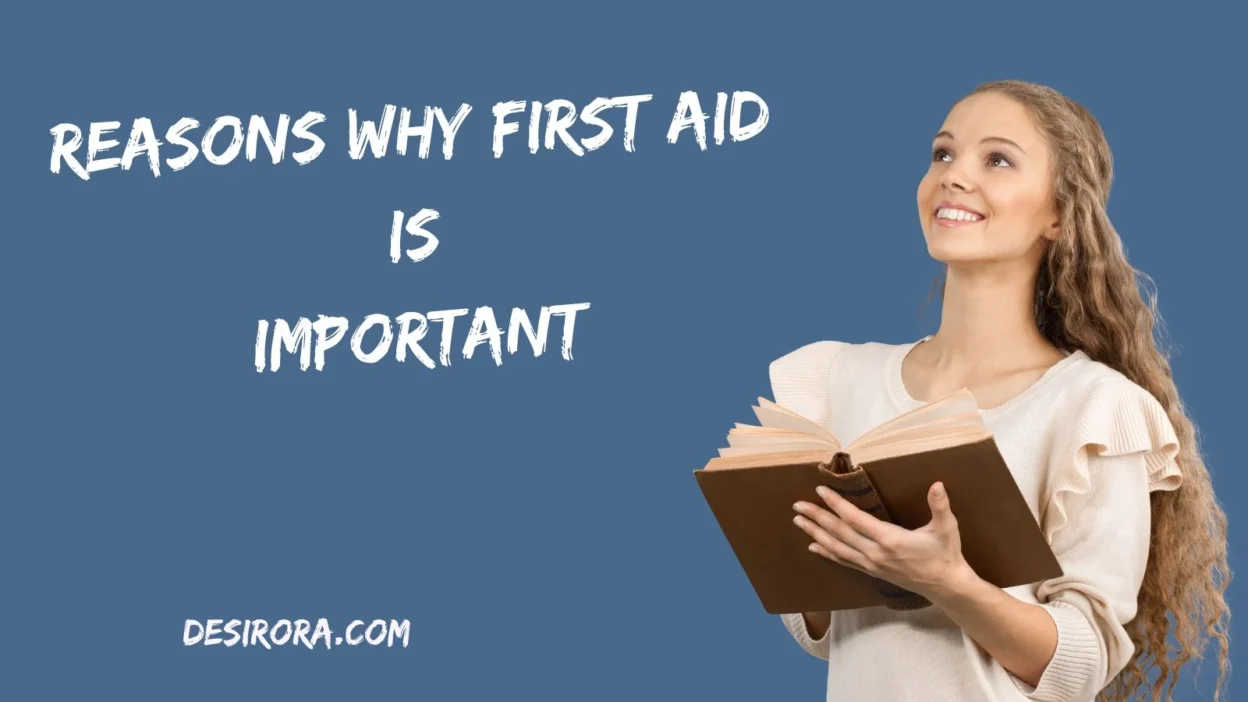First aid isn’t just a medical term—it’s a life skill. Whether in your home, at work, or out in public, knowing the basics of first aid can make a huge difference.
In this article, we’ll explore reasons why first aid is important, examine its benefits, and show you how to incorporate it into your life.
What Does First Aid Mean?
“First aid” refers to the immediate care given to a person who is injured or suddenly ill, before professional medical help arrives. It includes basic interventions—like stopping bleeding, managing choking, doing CPR, or treating minor burns. The goal is to preserve life, prevent the condition from worsening, and promote recovery.
Think of first aid like a bridge between the moment of injury and the arrival of emergency services. It doesn’t replace professional care, but it can buy crucial time.
Real-Life Stories: When First Aid Makes the Difference
Stories help illustrate why first aid matters.
- Case: Choking at dinner
Jane was dining with her family when her daughter started choking on a grape. Because Jane had learned the Heimlich maneuver, she acted quickly and dislodged the grape before panic set in. The child avoided serious injury. - Case: Bleeding wound at a construction site
Ahmed, a laborer, slipped and cut his arm deeply. A coworker applied direct pressure and secured a clean cloth bandage. By the time paramedics arrived, bleeding was under control, and there was less shock and complication. - Case: Cardiac arrest in public
During a conference, someone collapsed. A bystander performed chest compressions (CPR) immediately while someone else fetched the AED. That immediate response kept blood flowing, significantly improving the victim’s chances of survival.
These real-life situations show how first aid isn’t theoretical—it can truly sway outcomes.
Physical Benefits: Minimizing Harm and Promoting Recovery
Here are the key physical benefits:
- Stop or reduce bleeding
Uncontrolled bleeding can lead to hypovolemic shock. Applying pressure, elevation, or a tourniquet (in extreme cases) can stabilize the person until advanced care. - Prevent infection and safeguard wounds
Cleaning and dressing wounds promptly helps prevent infection, which can complicate recovery. - Support breathing and circulation
Rescue breathing or chest compressions can maintain oxygen flow. In choking, clearing the airway is crucial. - Immobilize fractures and sprains
Using splints, bandages, or slings helps prevent further damage until an X-ray or professional treatment is available. - Reduce pain and shock
Interventions like elevation, cold compresses, or keeping the person warm can mitigate pain and delay shock. - Provide early care in medical emergencies
For conditions such as heart attack, stroke, or seizure, early recognition and action can limit damage (e.g. by reducing “time to treatment” in a stroke).
Example Table: Common Injuries & First Aid Actions
| Injury / Condition | First Aid Action | Purpose / Benefit |
| Deep cut / bleeding | Apply firm pressure, elevate, bandage | Prevent blood loss, reduce clotting time |
| Sprain / twist | Immobilize, rest, ice, compress | Limit swelling and movement, reduce pain |
| Choking / airway blockage | Heimlich maneuver, back blows | Restore breathing |
| Cardiac arrest | CPR + AED (if available) | Maintain circulation until help arrives |
| Minor burn (1st/2nd degree) | Cool water, dress lightly, avoid infection | Reduce damage, prevent infection |
| Seizure | Turn to side, cushion head, time duration | Protect airway, prevent injury during event |
By intervening early, first aid can reduce the severity of injuries and sometimes prevent permanent damage.
Psychological Benefits: Confidence, Calm, and Control
Physical help is only half the story. The psychological benefits are equally powerful.
- Reduced anxiety and panic
When someone knows what to do, they’re less likely to freeze in a crisis. That calm can help others remain calm. - Increased confidence
You’ll feel empowered knowing you can help. That confidence often spreads; others might feel safer being around you. - Sense of control and purpose
In emergencies, uncertainty looms. Doing something—even a small action—gives you agency and direction. - Helping reduce trauma in others
Your calm first aid actions can reassure a victim, stabilizing their mental state. People often remember how someone spoke or held their hand more than the medical interventions.
A friend once remarked:
“I felt useless when my mom collapsed. But after taking a first aid course, I knew exactly what to do. That made me feel I could be her protector in a moment of crisis.”
That shift—from helpless bystander to informed responder—is transformative.
Social & Community Benefits: Helping Others, Saving Lives
When you carry first aid knowledge:
- You increase collective resilience.
More first-aiders in a community means more lives that can be saved before EMS arrives. - You become part of a supportive safety net.
Whether you’re in a crowd, church, club, or public event—people look to those who can help. - You foster a culture of care.
Communities who prioritize safety and first aid often run awareness programs, train youth, or host workshops. - Your actions might inspire others.
Seeing you step forward in a crisis encourages others to learn. It’s a positive ripple effect.
Community example: In some villages, school teachers get first aid training. When children fall or injure themselves on school grounds, teachers intervene immediately—reducing hospital visits for minor injuries.
Workplace & School Benefits: Why Every Institution Needs First Aid Know-How
Institutions—workplaces, schools, recreational centers—have specific reasons to embed first aid in their policies.
- Legal compliance & regulations
Many countries require workplaces to provide first aid kits and trained personnel. Compliance avoids fines or legal issues. - Reduced downtime and absenteeism
Quick intervention prevents worsening of injuries, leading to fewer days off work. - Improved safety culture
Employees feel cared for; accidents get noticed, reported, and prevented over time. - Liability protection
If someone is injured, having trained staff and documented first aid action shows due diligence. - Confidence among parents, clients, visitors
When people see staff are trained, they feel safer sending children, visiting facilities, or entering buildings.
Imagine a preschool that trains all teachers in first aid. A child falls, hits their head, and gets a rapid assessment. The teacher stabilizes and communicates with the parents. That responsiveness builds trust and might avert a serious outcome.
Legal, Ethical & Liability Considerations
Understanding the legal and ethical dimensions of first aid is important.
- Good Samaritan laws
In many places, laws protect people who volunteer first aid in good faith (as long as they don’t act recklessly). Check your local jurisdiction. - Consent
You should always ask for permission before treating someone who’s conscious. (“I’d like to help, is that okay?”) If the person is unconscious or unable to respond, implied consent is often assumed. - Scope of practice
Don’t attempt procedures beyond your training. Stick to basic protocols until professionals arrive. - Duty to report or refer
Some injuries or situations must be reported (e.g., in workplaces or schools). Ethical responsibility demands you alert professionals. - Documentation
In formal settings, record what you did, when, and how. That record can protect you in legal or institutional audits. - Avoiding harm
“First, do no harm.” If a procedure risks worsening a condition and you’re not trained, wait or provide supportive care.
These legal and ethical guardrails ensure first aid remains safe, respectful, and beneficial—for both you and the person in need.
Types of First Aid Skills Everyone Should Know
Here’s a breakdown of core first aid skills you should master:
| Skill / Topic | Why It Matters | What You Should Learn |
| CPR (Cardiopulmonary Resuscitation) | Keeps blood flowing | Chest compressions, rescue breaths, compression-only CPR |
| AED (Automated External Defibrillator) | Restart heart rhythm | Turn-on, pad placement, shock protocol |
| Choking relief | Restore breathing | Heimlich maneuver, back blows, chest thrusts |
| Bleeding control | Prevent blood loss | Direct pressure, elevation, tourniquets |
| Fracture management | Protect bones, nerves | Splinting, stabilizing, immobilization |
| Burns & scalds | Reduce damage, pain | Cooling, dressing, avoiding infection |
| Shock management | Prevent collapse | Warmth, supine position, calm environment |
| Poisoning & overdose | Prevent damage | Activated charcoal (if trained), position, call poison control |
| Allergic reactions / Anaphylaxis | Allergic shock can kill | Epinephrine auto-injector, anti-histamines, calling immediate help |
| Fainting / unconsciousness | Prevent choking / injury | Positioning, airway checks, recovery position |
| Seizure first aid | Protect injury, airway | Cushion, turn side, don’t restrain limbs |
| Basic wound care & dressing | Prevent infection | Cleaning, antiseptics, sterile gauze, bandaging |
You don’t need to master every medical specialty—just the basics. A good first aid course (or refresher) will cover these skills, usually combining theory with hands-on practice.
Common Myths & Misconceptions About First Aid
Let’s debunk some myths that might hold people back from learning:
| Myth | Reality |
| “I’ll make things worse if I try” | Basic first aid, properly taught, is safer than doing nothing. Training minimizes risk. |
| “Only medical professionals should help” | Anyone with basic training can make a huge positive difference. |
| “I’ll get sued if something goes wrong” | Good Samaritan laws exist in many places to protect helpers acting in good faith. |
| “First aid is complicated and technical” | It’s mostly straightforward, intuitive actions once you’ve practiced. |
| “I’ll forget everything” | Regular refreshers, drills, and referring to guides help retention. |
| “It’s too expensive” | Many affordable courses or community sessions are available; cost is usually low relative to benefit. |
Recognizing myths helps people overcome fear and take action.
How to Get Quality First Aid Training
Here’s how to find and get good training:
- Choose a reputable organization
Look for groups like Red Cross, local health departments, EMS agencies, or certified first aid providers. - Check for certification and credibility
Ensure the course is recognized or accredited. Certifications from health ministries or recognized NGOs count more. - Look for hands-on, scenario-based sessions
Learning theory is fine, but practicing on manikins or through role play builds muscle memory and confidence. - Take a course suited to your environment
If you work near water, include drowning response. If in industry, include industrial injuries, etc. - Include refresher courses
Skills degrade over time. Aim for refreshers every 1–2 years (or per your local recommendation). - Use supplemental resources
Apps, pocket reference cards, and periodic drills help reinforce your learning.
When choosing, ask: Who trains? What is the instructor’s qualification? How many hours of hands-on practice? Are certificates recognized by local authorities?
Maintaining and Updating Your First Aid Skills
Learning once isn’t enough. Here’s how to keep sharp:
- Schedule periodic refreshers
Every 6 to 24 months, depending on guidelines. - Simulate drills
Run mock emergencies at home or work. Practice with family or coworkers. - Review updates in protocols
Medical guidelines evolve. Stay alert to changes from Red Cross, WHO, or your local health department. - Use mobile apps or flashcards
Apps often provide quizzes and visual reminders. - Join a first aid group or community
Meetup groups or local volunteer organizations often host regular review sessions. - Teach others
If you teach friends or family, you reinforce your own skills. - Carry a compact first aid reference
Even a simple card with flowcharts can guide you under stress.
Summary of Key Points
- First aid bridges the critical gap between injury and professional care.
- It offers physical benefits (reduced harm, better recovery) and psychological benefits (confidence, calm).
- Communities, institutions, and workplaces gain resilience, trust, and compliance when first aid is integrated.
- Legal and ethical safeguards protect helpers and victims alike.
- Core first aid skills—CPR, bleeding control, burns management, etc.—are within reach for most people.
- Debunking myths encourages participation.
- Quality training and continuous refreshers are essential to maintain competence.
FAQs
Q: Do I need to be a medical professional to use first aid?
A: No. First aid is designed for non-medical people. Basic life support, wound care, and stabilization are taught to ordinary individuals. With proper training, you can safely assist others until medical help arrives.
Q: How long does first aid training take?
A: Many basic courses run from 4 to 8 hours. More comprehensive certifications (including CPR, AED, trauma, etc.) may span one or two days. Refresher courses are shorter.
Q: Can first aid make things worse?
A: If you attempt procedures beyond your training, yes, it could. That’s why courses stress working within your limits. The correct basic responses are safer than doing nothing.
Q: Does first aid expire or get outdated?
A: Not exactly “expire,” but guidelines change over time, and skills fade. That’s why refreshers every 1–2 years are recommended.
Q: How do I convince my workplace to provide first aid training?
A: Point out benefits: fewer work disruptions, legal compliance, improved safety culture, and reduced liability. Present a cost–benefit: the small course cost is minor compared to potential harm. Offer to organize group sessions or local courses.
Conclusion
Knowing reasons why first aid is important isn’t just theory—it’s a commitment to being part of the solution during emergencies. First aid gives you the tools to act swiftly, safely, and confidently. It saves lives, reduces harm, and amplifies your role in your family, workplace, and community.
Take the step today: enroll in a reputable first aid course, practice those skills, refresh often, and share your knowledge. That way, you’re not just a bystander—you’re a capable responder. Whenever life throws surprises, you’ll be ready.

Thomas Hardy is a passionate innovator and thoughtful leader, dedicated to transforming ideas into lasting success. With creativity and purpose, he brings vision and authenticity to everything he does.



